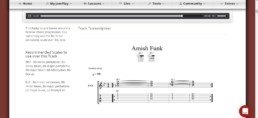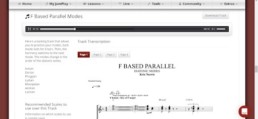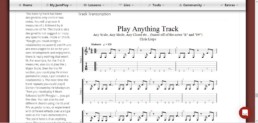JP BLOG
Share this
As most self-taught musicians know, finding quality backing tracks to practice your soloing and accompaniment on can be a major hassle. I have spent countless cumulative hours scouring Youtube looking for a backing track with the right “feel” and, if I’m lucky, in the right key.
Fortunately for us, Jamplay has the widest and most diverse selection of backing tracks that I’ve ever seen on one site. When I first tried out their JamTracks in Tools, I was blown away with the sheer quantity of tracks. I felt like a kid in a candy store and I had to try them all.
At first I just flitted around the list, mostly selecting by the names of the tracks (I think Amish Funk is what first got my attention). The tracks themselves are usually about five minutes long and far from your typical four-bar loops. These backing tracks have layered, constantly evolving accompaniment that will force you to listen! You’re not playing over some mindless drones. There’s actual musical topography for you to explore and react to for any genre.

Better yet, there’s even an added transcription of the tracks if you want to dive deep into the theory of what you’re playing over. The transcription includes the chord names, the chords written out in standard notation, and the chords in tab. You truly cannot ask for more. Even so, JamTracks still delivers and gives you suggested approaches and scales for the backing tracks
The massive amount of options and opportunity can be a bit daunting, especially if you’re looking for a specific genre to work on. Thankfully there’s an option to filter by Genre, Key, or Instructor. Each genre gets its fair share of the tracks with Rock having the largest selection.
The actual quality of the recordings needs to be mentioned. I definitely expected it to all sound “computery” and stale but I truly would not be able to tell if these were all programmed or recorded by an actual band. The tones are rich, the drums are vibrant, and I didn’t feel like I was playing along with robots.
So how would one best go about using JamTracks for practicing? These backing tracks could serve many purposes. They could be great “leisure tools” i.e. something to unwind with at the end of your practice session as a kind of reward. Likewise they could also be used to warm up your fingers before getting deep with a metronome or into a specific technique you’re trying to master.
The JamTracks themselves are great tools for learning both theory and song structure. Because the tracks are transcribed, you can actually see the “skeleton of the music” and analyze what’s going on. You can learn new chords, how to use them, and where to use them. Some of the jazz backing tracks get into some pretty advanced theory in terms of following rapidly changing chords, but they avoid the fatal mistake of explaining too much too fast.

What I really love about these backing tracks is that they target the different feels of music. What you learn from one feel you can apply to another, regardless of genre. The grooves you learn from Southern Metal are directly related to grooves you’ll use in Funk.
My only word of warning is be wary of getting lost in all the tracks. Use them in a targeted, deliberate manner in order to focus on one particular concept (minor pentatonics, chord changes, etc.) as you pursue larger lesson objectives. Overall these backing tracks are an invaluable tool in your toolbox. They’re not the end all be all of practicing, but they’ll add a lot of fuel to the fire and should accelerate you on your way to musical mastery like few other online resources can.
So with all this in mind, here’s a quick step-by-step guide for maximizing your use out of these JamTracks.
Find Your Target Area
Are you trying to get better at being able to “shred on demand” or are you looking to develop a lighter touch with your music? Setting goals like these should be your first priority in terms of bettering yourself as a musician.
Work Your Way Up
If you’re trying to develop your fluency as a jazz guitarist, don’t start with pan-modal backing tracks (that term sounds just as convoluted as it is). Instead, start with simple 2-5-1’s or Blues Progressions. The same goes for other genres. There’s no shame in slow metal grooves, just as there is no shame in four chord pop songs. We all have to start somewhere.
Analyze The Tracks

As I said before, these aren’t mindless backing tracks, and you’re not some mindless musician. Be mindful about what you’re doing. Ask why those chords are played where they are played. Challenge yourself to play those chords in a different way, in a different place on the neck.
Stick With The Tracks
If you like a certain track, keep working with it! Try to dig out all the possible sounds you can hear from the implications of the chords. Don’t just noodle the same old thing the same old way over the same old track. Really try to stretch the limits of what you can play. Don’t play just what works, play what sounds good to you, and push that to the breaking point.
All in all, it’s important to keep in mind that these tracks are tools. They are not the finished product. Use them, use them as often as you can, but do not confuse them with yourself. We use backing tracks to prepare ourselves to play with other musicians, and if you get in the habit of thinking of all music as a backing track, you’re in for a very rough time indeed.
Ready to try JamTracks? Become a member and join the more than 500,000 guitarists who have experienced JamPlay. Try out JamTracks and tap into guitar lessons from world class instructor artists in every genre and for every interest to power up your guitar skill. Become a member today at JamPlay.com.

